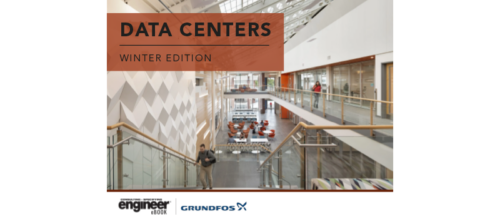Medium voltage increases savings to power multistory data centers
Incorporating medium voltage power distribution systems into multistory data centers delivers site benefits but must be planned carefully for safe and effective installation.
Electrical safety insights
- Safety measures, including proper system design, advanced monitoring, control systems, remote operation and automatic shut-offs, are essential to mitigate the safety hazards associated with medium voltage power distribution in data center environments.
- Medium voltage power distribution systems in multistory data centers offer cost-saving benefits through reduced installation and copper costs.
As available real estate continues to diminish and become more expensive, data center developers are embracing the reality that if they can’t build out, they build up. Typically, building up is more expensive, especially if the designer stays within the constraints of low-voltage power distribution systems —typically 480 Volts. In an effort to help contain those costs, considerations should be made for shifting to a medium voltage power distribution system (typically, 5 to 69 kV) solution that brings lower costs of implementation and maintenance, along with a more reliable and stable power source that has less carbon emissions. That said, medium voltage (MV) power distribution in a multistory data center is a complex undertaking that requires careful planning and attention to detail to ensure power is safely delivered to the equipment.
Case study scenario parameters:
-
2 or more story building
-
13,200 V (15 kV class) medium voltage power distribution
-
Centralized electrical distribution system, with dual ended, main-tie-tie-main substations located on the floor adjacent to the data centers.
Moving from high- to medium-voltage power distribution
MV power distribution in multistory data centers use electrical switchgear and transformers to step down the incoming MV power from the utility grid and on-site power generation to the appropriate voltage level (typically 480 V) required for the equipment. This involves the use of MV switchgear, distribution equipment and substations with step down transformers to distribute utility power and on-site power generation in the event of a commercial power failure. At the utility, distribution automatically transfers between the services, and in the event of a total commercial power failure, transfers to on-site standby generators.
Substations should be placed close to the end user’s load to reduce installation and copper costs. The distribution costs are lower for large amounts of electrical power at higher voltages because a single four-inch conduit can distribute up to 4,000 kilowatts of electrical power at 13,200 V, whereas at 480 V, this will require up to 12 x 4 in. conduits (or busway) requiring more copper, heat and complications.
Substations are positioned in a main-tie-tie-main arrangement with each side of the substation in physically separated rooms. Separate MV circuits are provided for each side of the substation as well as an independent MV generator supply and a primary cross tie between the substations.
With data centers, reliability and redundancy are a paramount concern. This includes:
- Parallel, redundant programmable logic controllers: These should be installed in physically separated enclosures. This will allow for updates and changes in the control sequences while maintaining operational control.
- Redundant input/output (I/O) interfaces: This removes the I/O as a single point of failure.
- Multiple power sources for the controls and breaker operations: There should be an 83 relay to switch between power sources. At least one of the power sources should be directly from the on-site generator system.
- Black start relay: This relay to be programmed to start the on-site generators in the event of a complete control power loss.
- Concurrent maintainability: Any single device in the electrical distribution system can be taken offline for maintenance while maintaining full operation in the data centers, with the understanding there will be a potential loss of redundancy during maintenance.
- Solid state, multi-function, programmable MV relays: After the electrical system is installed, changes may be required during start up.
- Comprehensive monitoring system: This should include multi-channel communications capability.
- Neutral grounding resistor: This presents a lower impedance path to ground for fault currents and can be programmed to shut down the generator(s) in the event of a ground fault to minimize damage.
- Snubbers: For close coupled, MV distribution systems, there is the possibility of switching transients when using vacuum breakers and VPI transformers. This is a result of the internal mechanics of the breakers and the quick interruption of voltage, which generate voltage at higher frequencies than 60 Hz. The snubber presents a low impedance path to ground for this energy and can prevent internal damage to the downstream transformer.
These are some of the important design considerations for a successful MV conversion.

Figure 1: A typical riser diagram demonstrates how medium voltage power systems can operate within multi-story data centers. Courtesy: Bala
Safety considerations for power systems
With the efficiencies and cost savings gained from using MV distribution systems, safety must also be a top consideration. MV power can be very dangerous, and it is important to take appropriate safety measures to protect people and equipment. The electrical system must be properly designed and installed to minimize the risk of electrical faults, which can be a significant safety hazard. The safest strategy is to provide an electrical distribution system that allows for shutdown of each path of the electrical equipment to perform maintenance and operation of de-energized equipment. In case of a power outage or failure, this may involve the use of backup generators and uninterruptible power supply systems to ensure critical equipment remains powered and operational.
Additional safety precautions may involve using advanced monitoring and control systems to detect and isolate faults before they can cause damage or pose a risk to personnel. It can also include the use of remote operators, such as a human-machine interface (HMI) located out of the arc flash zone to operate the distribution equipment and remote operating equipment to safely rack-in and rack-out the breakers from safe distances. The design also should include the installation of safety features like automatic shutoffs.
Using experienced engineers who are well versed in MV power distribution systems, and all of the unique characteristics and considerations for multistory data centers, can be the key to realizing a beneficial shift. A solution that provides construction cost savings while reducing maintenance requirements for long-term operations and promoting safety comes from an experienced and reliable team.
Do you have experience and expertise with the topics mentioned in this content? You should consider contributing to our CFE Media editorial team and getting the recognition you and your company deserve. Click here to start this process.




